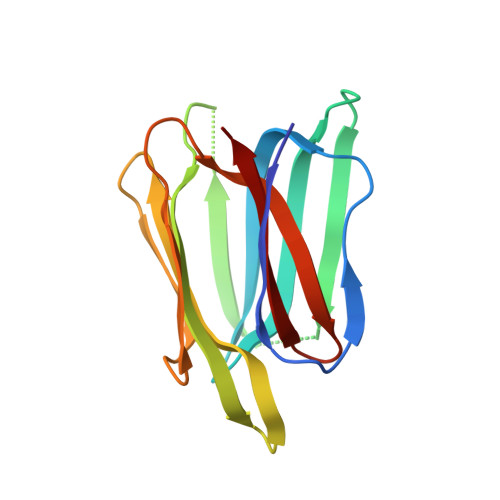Distinct roles for each N-glycan branch interacting with mannose-binding type Jacalin-related lectins Orysata and Calsepa.
Nagae, M., Mishra, S.K., Hanashima, S., Tateno, H., Yamaguchi, Y.(2017) Glycobiology 27: 1120-1133
- PubMed: 28973127
- DOI: https://doi.org/10.1093/glycob/cwx081
- Primary Citation of Related Structures:
5XFH, 5XFI - PubMed Abstract:
Mannose-binding type Jacalin-related lectins (mJRLs) bind to branched N-glycans via conserved sugar-binding sites. Despite, significant 3D structural similarities, each mJRL is known to have a unique binding preference toward various N-glycans. However, the molecular basis of varying binding preference is substantially unknown. Here, we report a detailed comparison of N-glycan-binding preference for two mJRLs, Orysata and Calsepa using frontal affinity chromatography (FAC), X-ray and molecular modeling. The FAC analysis using a panel of N-glycans shows difference in N-glycan-binding preference between the lectins. Orysata shows broader specificity toward most high-mannose-type glycans as well as biantennary complex-type glycans bearing an extension on the Manα1-6 branch. Whereas, Calsepa shows narrow specificity to complex-type glycans with bisecting GlcNAc. The X-ray crystallographic structure reveals that two Orysata lectins bind to one biantennary N-glycan (2:1 binding) where one lectin binds to mannose of the α1-3 branch, while the other interacts with an N-acetylglucosamine of the α1-6 branch. In contrast, Calsepa shows 1:1 binding where α1-3 branch and core chitobiose region N-glycan interacts with lectin, while α1-6 branch is flipped-back to the chitobiose core. Molecular dynamics study of Orysata bound to N-glycans substantiate possibility of two-binding modes for each N-glycan. Binding free energies calculated separately for α1-3 and α1-6 branches of each N-glycan suggest both branches can bind to Orysata. Overall these results suggest that each branch of N-glycan has a distinct role in binding to mJRLs and the nonbinding branch can contribute significantly to the binding affinity and hence to the specificity.
- Structural Glycobiology Team, Systems Glycobiology Research Group, RIKEN Global Research Cluster, 2-1 Hirosawa, Wako, Saitama 351-0198, Japan.
Organizational Affiliation:

















